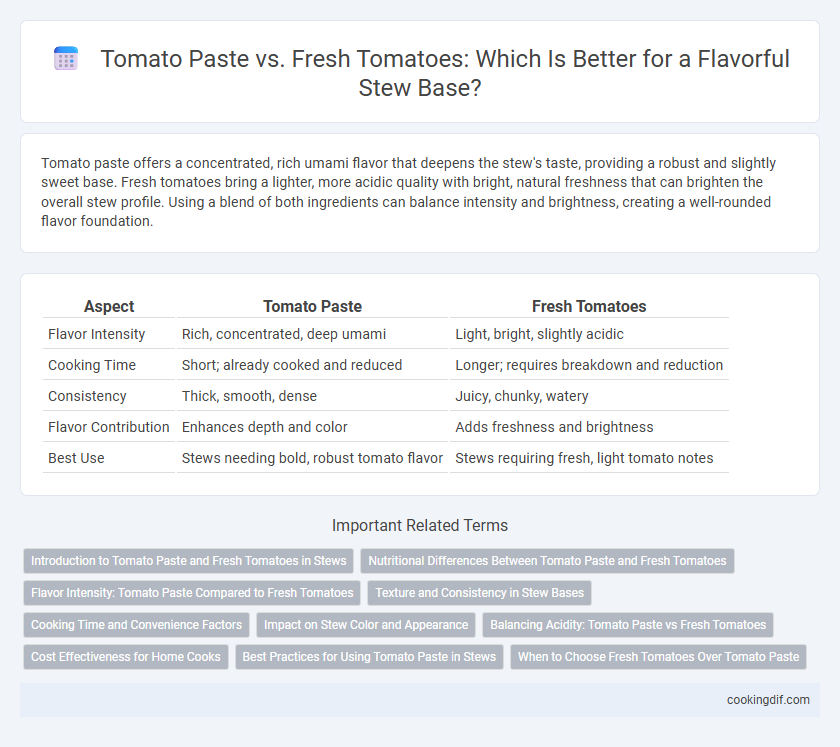Tomato paste offers a concentrated, rich umami flavor that deepens the stew's taste, providing a robust and slightly sweet base. Fresh tomatoes bring a lighter, more acidic quality with bright, natural freshness that can brighten the overall stew profile. Using a blend of both ingredients can balance intensity and brightness, creating a well-rounded flavor foundation.
Table of Comparison
| Aspect | Tomato Paste | Fresh Tomatoes |
|---|---|---|
| Flavor Intensity | Rich, concentrated, deep umami | Light, bright, slightly acidic |
| Cooking Time | Short; already cooked and reduced | Longer; requires breakdown and reduction |
| Consistency | Thick, smooth, dense | Juicy, chunky, watery |
| Flavor Contribution | Enhances depth and color | Adds freshness and brightness |
| Best Use | Stews needing bold, robust tomato flavor | Stews requiring fresh, light tomato notes |
Introduction to Tomato Paste and Fresh Tomatoes in Stews
Tomato paste provides a concentrated, rich umami flavor that intensifies the stew's depth, offering a thicker consistency and a slightly sweet, caramelized taste due to its slow cooking and reduction. Fresh tomatoes contribute a brighter, lighter acidity with a more natural, subtle sweetness that allows the other ingredients to shine, maintaining a fresher and more vibrant flavor profile. Using tomato paste or fresh tomatoes as a flavor base in stews depends on the desired balance between richness and brightness, with tomato paste delivering a bold, robust essence and fresh tomatoes adding fresh, tangy nuances.
Nutritional Differences Between Tomato Paste and Fresh Tomatoes
Tomato paste contains a concentrated amount of nutrients, providing higher levels of lycopene, vitamin C, and antioxidants per serving compared to fresh tomatoes. Fresh tomatoes offer more hydration and a broader spectrum of vitamins, including vitamin K and folate, with lower calorie density. The choice between tomato paste and fresh tomatoes in a stew influences not only flavor depth but also the nutritional profile, with paste enhancing density of nutrients while fresh tomatoes contribute freshness and hydration.
Flavor Intensity: Tomato Paste Compared to Fresh Tomatoes
Tomato paste offers a concentrated umami flavor with a rich, deep tomato intensity that enhances the savory profile of stews, whereas fresh tomatoes provide a lighter, more acidic and fruity taste. The caramelized notes in tomato paste develop through cooking down, resulting in a thicker consistency and robust flavor that stands out in slow-cooked dishes. Using tomato paste intensifies the stew's base, creating a fuller, more complex tomato flavor compared to the subtle freshness of whole or chopped fresh tomatoes.
Texture and Consistency in Stew Bases
Tomato paste provides a thick, concentrated texture that creates a rich and glossy base for stew, enhancing the consistency without adding excess liquid. Fresh tomatoes contribute a lighter, chunkier texture with more moisture, which can result in a thinner stew base and a more vibrant tomato flavor. Combining both ingredients balances the stew's thickness while maintaining a fresh, robust taste.
Cooking Time and Convenience Factors
Tomato paste provides a concentrated, rich flavor base that thickens stews quickly, reducing overall cooking time compared to fresh tomatoes, which require longer simmering to break down and develop depth. Fresh tomatoes offer a brighter, fresher taste with natural acidity but involve prep time such as peeling and chopping, affecting convenience. For busy cooks seeking speed and consistency, tomato paste is a practical option, while fresh tomatoes suit recipes where nuanced, layered flavors are desired despite longer cooking.
Impact on Stew Color and Appearance
Tomato paste creates a rich, deep red color that intensifies the stew's appearance, providing a glossy, concentrated look. Fresh tomatoes contribute a lighter, more varied red hue with natural chunks that give a rustic, textured visual appeal. The choice between paste and fresh tomatoes directly affects the stew's color vibrancy and overall presentation, influencing how hearty and bold the dish appears.
Balancing Acidity: Tomato Paste vs Fresh Tomatoes
Tomato paste offers a concentrated flavor with rich umami and balanced acidity, making it ideal for enhancing the stew's depth without overwhelming sourness. Fresh tomatoes provide a brighter, more natural acidity that can lighten the stew's overall taste but may require longer cooking to mellow harsh tartness. Combining tomato paste and fresh tomatoes allows precise control over acidity, achieving a harmonious flavor base tailored to the desired stew profile.
Cost Effectiveness for Home Cooks
Tomato paste offers a cost-effective solution for home cooks seeking a rich, concentrated tomato flavor base in stews, requiring less quantity compared to fresh tomatoes. Fresh tomatoes, while providing a vibrant, natural taste and texture, often demand more preparation time and larger amounts to achieve the same intensity. Opting for tomato paste minimizes waste and storage issues, making it a budget-friendly choice without compromising the stew's depth of flavor.
Best Practices for Using Tomato Paste in Stews
Tomato paste provides a concentrated umami flavor that intensifies the richness of stews without adding excess liquid, making it ideal for a robust base. For best results, saute the tomato paste briefly in oil before adding other ingredients to caramelize its sugars and deepen the stew's flavor profile. Using fresh tomatoes can introduce brightness and acidity but often requires longer cooking times to break down, whereas tomato paste delivers immediate depth and complexity.
When to Choose Fresh Tomatoes Over Tomato Paste
Fresh tomatoes provide a bright, acidic flavor and a juicy texture that is ideal for stews requiring a lighter, more vibrant base, especially when the recipe calls for a fresh, natural tomato taste. Use fresh tomatoes when cooking stews with delicate vegetables or seafood, as their subtle sweetness preserves the dish's freshness without overpowering other ingredients. Fresh tomatoes are preferred during the summer months when ripe, flavorful tomatoes are readily available, ensuring optimal flavor and freshness in your stew.
Tomato Paste vs Fresh Tomatoes for flavor base Infographic

 cookingdif.com
cookingdif.com